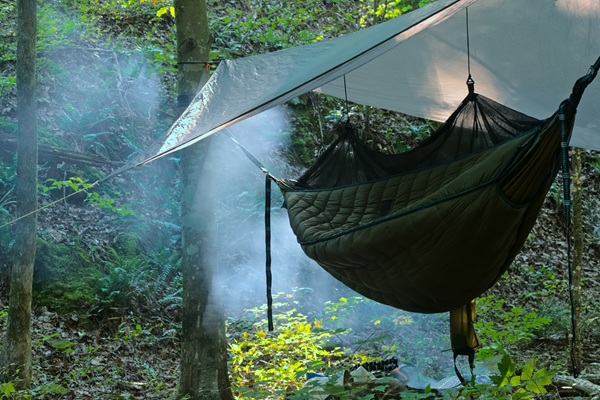Learn about Hammocks for Backpacking

Table of Contents
Pros & Cons of Hammocks
Pros Cons
Better than tents when the ground is sloped, uneven, muddy, swampy, rocky, or covered with brush
More comfortable than sleeping pads in tents
No condensation
Can be used as a chair
More compact than most tentsRequires trees with appropriate spacing
Steeper learning curve than most tents
Takes longer to set up than most tents
Colder and less rainproof than tents
Can’t store much gear in them
More components than tents
Only fits 1 person if a single hammock; only fits 2 people if a double hammock
Most hammocks (except ultralight hammocks) are a little heavier than most tents
Components of a Hammock System
Hammocks for backpacking typically have the following components:
- Hammock
- Suspension system
- Structural ridgeline (not in all hammocks)
- Tarp
- Top quilt or sleeping bag
- Underquilt and/or sleeping pad
- Bug net
Single vs Double Hammocks
Most hammocks are single hammocks for one person.
Double hammocks theoretically fit two people. I’ve never tried sharing one with another sleeper, but I hear it’s uncomfortable. You can use a double hammock just for yourself for added space and comfort, but it will add weight and bulk to your backpack. A double hammock probably isn’t a good choice for budget backpackers.
Gathered-end Hammock
In a gathered-end hammock, the fabric is bunched up into a point at each end. Gathered-end hammocks are shaped like a banana, with a curved sleeping surface that’s low in the middle and high on the ends.
Bridge Hammock, aka Spreader-bar Hammock
A bridge hammock has a spreader bar at each end to prevent it from bunching into a point. Bridge hammocks have a flat sleeping surface and a rectangular shape.
Pros & Cons of Gathered-end vs Bridge Hammocks
Pros Cons
Gathered end Lightweight
Compact
Easier to set up
Don’t require as much space between trees
AffordableUncomfortable for side sleepers and stomach sleepers
Less space
Bridge Comfortable for all sleeping positions
More space Heavy
Bulky
Harder to set up
Require more space between trees
Structural Ridgeline
Some hammocks have a structural ridgeline, a cord attached from one end of the fabric to the other. It lets you control the amount of hammock sag independently of the suspension.
Tarp
A waterproof tarp is hung over the hammock to keep out rain.
Underquilt and/or Sleeping Pad
An underquilt hangs under your hammock to keep you warm. Many underquilts are designed to fit specific hammock models.
Instead of using an underquilt, you can also put a sleeping pad on top of the hammock. However, it might not be as warm as a high-end underquilt, and it might be hard to fit it comfortably in your hammock.
Bug Net
The bug net for your hammock should have:
- No-see-um netting with fine enough mesh to keep out gnats
- 360-degree protection, meaning that it hangs underneath the hammock to prevent insects from biting you through the hammock.
